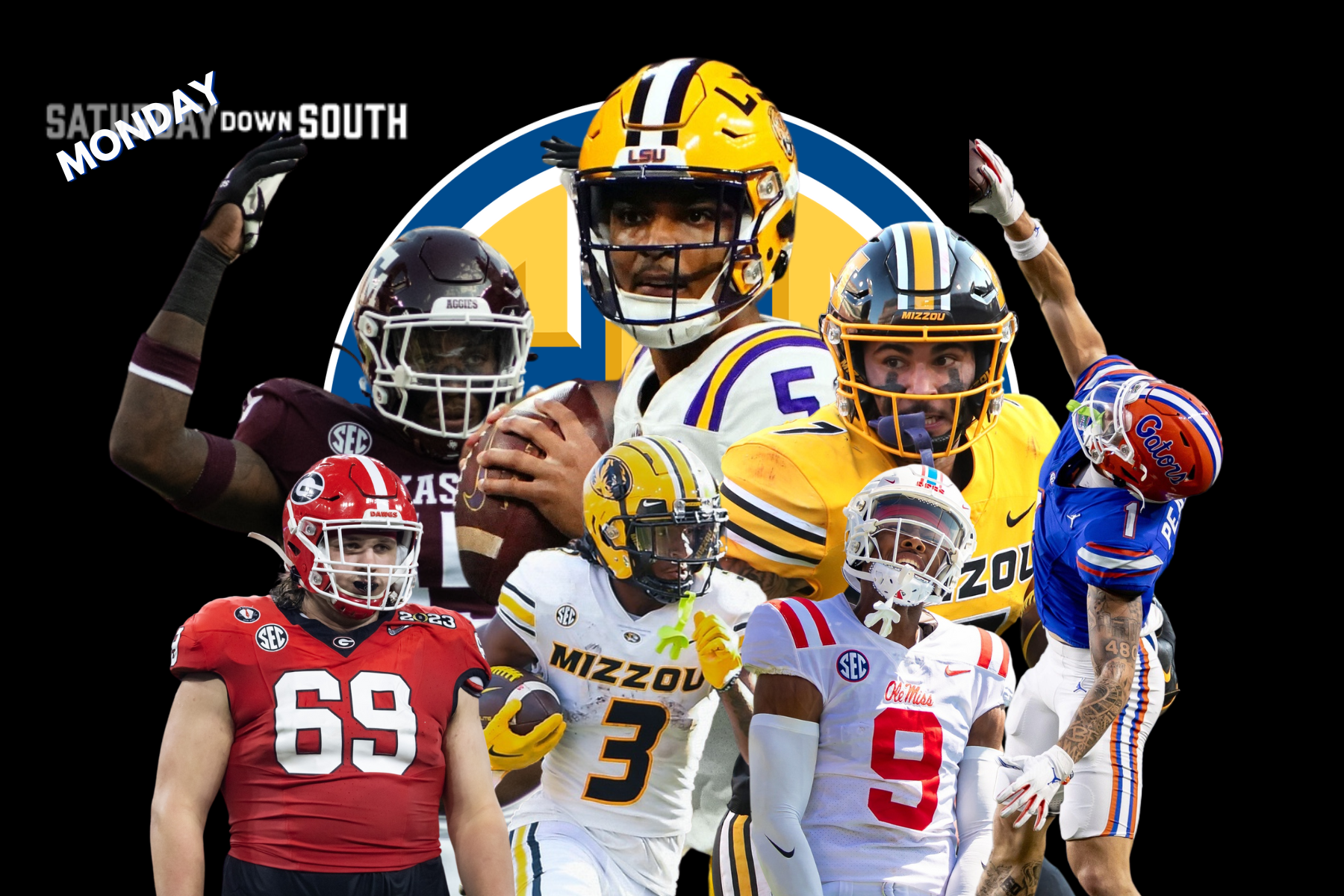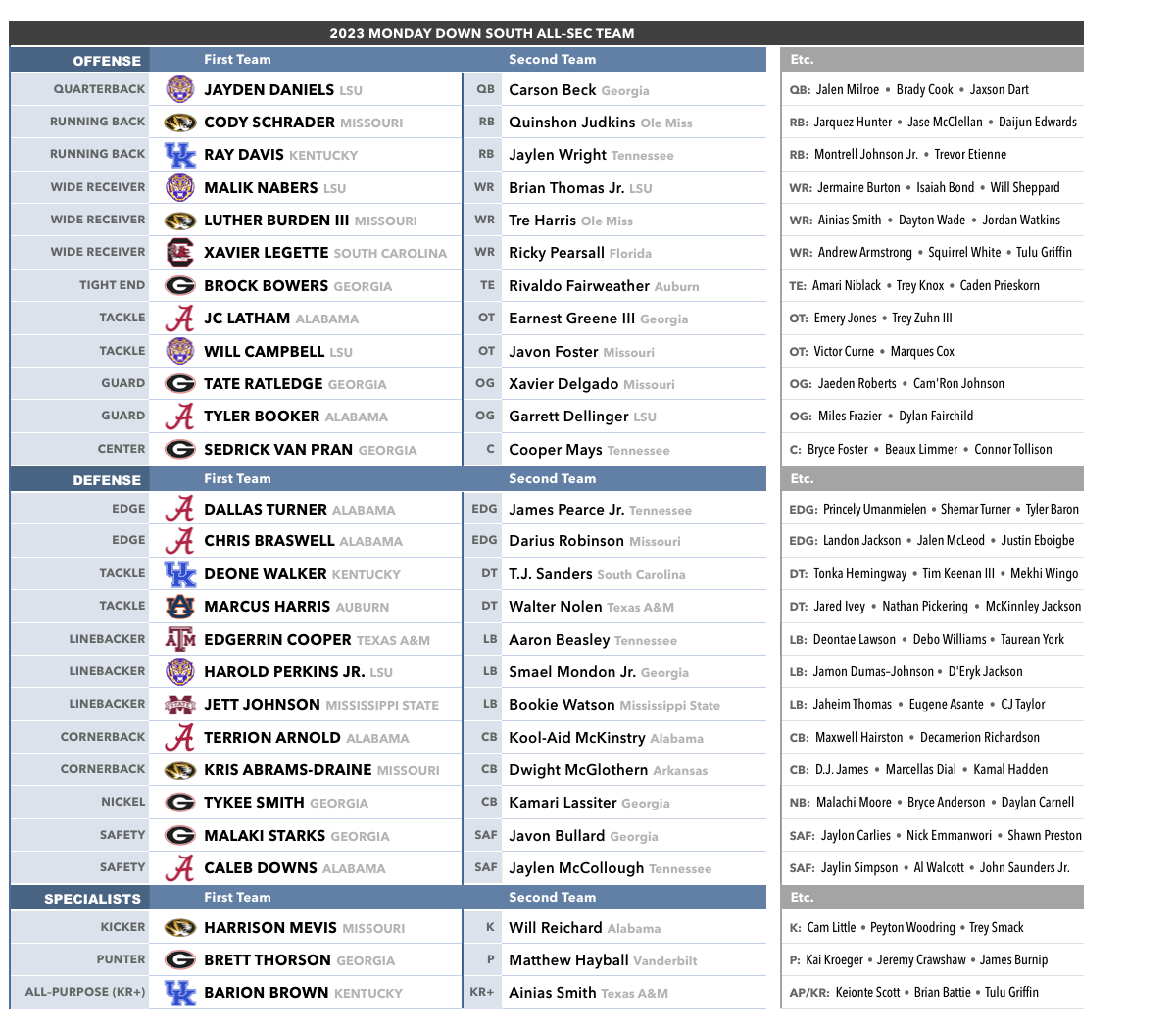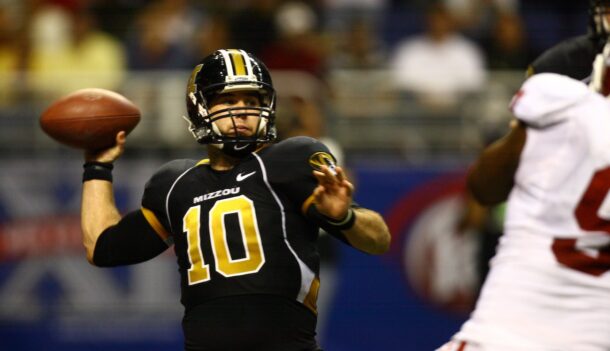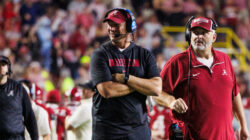
Monday Down South: The 4-team Playoff failed its first (and last) big test because success was not an option
By Matt Hinton
Published:
Weekly takeaways, trends and technicalities from the final weekend of the SEC season.
Chaos finds a way
It took a decade, but the pilot version of the College Football Playoff finally ran up against the limits of its mandate. If it wasn’t already due for a reboot in 2024, the ’23 season would be destined to go in the books as the one that officially fried the system.
In this sport, it was only a matter of time. After an unusually chalky regular season, the final weekend opened with 8 teams plausibly in the running for 4 slots. It ended on Saturday night with 5 teams — all winners in their respective conference championship games, all clearly worthy of a Playoff berth by any prevailing standard — left standing. The committee, having made it this far into its existence unscathed, was left with its first true Sophie’s choice: Five teams. Four tickets. One’s gotta go. And no matter which one they settled on, the choice itself would represent a fundamental challenge to the integrity of the project.
In fact, in the course of playing an overnight game of Rock/Paper/Scissors over the relative merits of Alabama, Florida State and Texas, not only the committee but everyone who follows the sport was forced to confront the question at the heart of the debate: Just what is the project, anyway? When in doubt, what really counts, and what doesn’t?
The committee’s official protocol is deliberately vague, noting in its first sentence that “[r]anking football teams is an art, not a science.” True enough, as anyone who’s ever attempted to do it can confirm. Backing yourself into a corner with a rigid set of criteria or formula, a la the BCS, is a recipe for disaster — a la the BCS. But just as the old system never solved for the problem of routinely finding itself with 3 or 4 (or more) deserving teams for only 2 spots in the designated championship game, it turns out there is no art for turning 4 chairs into 5. There are only more unsatisfying excuses for why the music happened to stop when it did.
The team left chairless and embittered, of course, was 13-0 Florida State, which owns what in any other context would be considered an unimpeachable résumé. The Seminoles have won 19 straight dating to last October, with wins in that span over Oklahoma, Miami (twice), Florida (twice), LSU in the ’23 season opener, Clemson (at Clemson) and Louisville in Saturday’s ACC Championship Game. Their 16-6 win over the Cardinals was their 10th of the year by 9+ points and clinched FSU’s first conference title since 2014. Altogether, they’ve posted a wider scoring margin this season than 3 of the 4 teams that made the Playoff cut ahead of them (Michigan being the exception), nearly doubling up Power 5 opponents. They boast likely first-rounders on both sides of the ball and an abundance of future pros otherwise.
In the specific context of this year’s Playoff race, though, the committee was more concerned with Florida State’s only notable loss: Face-of-the-program QB Jordan Travis, whose season-ending ankle injury against North Alabama in Week 12 was specifically cited by committee chair Boo Corrigan as the key factor in the committee’s decision to treat the post-Travis Noles like a bunch of off-brand pretenders rather than major conference champs. With Travis on crutches, the defense took the lead in closing out the unbeaten season with 2 different backup QBs making their first career starts in consecutive weeks.
One way to look at that would be to see a balanced outfit stepping up in the face of adversity to take care of its business against a couple of legit opponents without its star. The other way — the one the committee seized on, in light of the unavoidable fact that somebody in this equation had to get screwed — was to ignore the results and preemptively dismiss them as a team that just doesn’t feel like a winner.
“One of the questions that we do ask, is from a coaching standpoint, you know, who do you want to play, who do you not want to play?” Corrigan said on Sunday. “You look at who they are as a team right now without Jordan Travis, without the offensive dynamic that he brings to it, they are a different team.”
And with that, the 4-team iteration of the CFP came full circle: From part of the solution to part of the problem; from a vision of the future to a dull rehash of the past; from an idea whose time has come to an idea whose time has passed, all in the tidy span of a decade.
devastated. heartbroken. In so much disbelief rn, I wish my leg broke earlier in the season so y’all could see this team is much more than the quarterback. I thought results matter. 13-0 and this roster matches up across any team in those top 4 rankings. I am so sorry. Go Noles!
— Jordan Travis (@jordantrav13) December 3, 2023
Given that this an SEC-dedicated space, I assume the audience here is broadly less sympathetic to FSU’s plight than the rest of the country in light of Alabama’s 27-24 upset over mighty Georgia — undeniably a championship-caliber performance, and one that, again, in any of the first 9 seasons of the Playoff’s existence would have vaulted the Tide into the Final Four without the slightest whiff of the controversy that met their announcement as the No. 4 seed on Sunday. How could a 12-1 SEC champion with a convincing win over the wire-to-wire No. 1 team in the country in Atlanta possibly not make the cut, right? To suggest otherwise is just as big an insult as downgrading the ACC champ on the basis of a key injury, or ignoring Texas’ head-to-head win in Tuscaloosa in September.
But set aside for a second the cherry-picked arguments about the committee “getting it right” to consider why those arguments are necessary in the first place: Under the circumstances, there was no way to “get it right” without also getting it very wrong.
It just so happens that the particular way they chose to get it wrong struck a couple of unnerving chords. One, it flew in the face of the deference to undefeated teams that’s held across the sport’s modern era, replacing it with the idea that a panel of judges, in its wisdom, can substitute its own opinions — or, worse, its own predictions — for the actual results on the field. Why play the games if the powers that be reserve the right to ignore them for whatever reason they can come up with in a pinch to justify their hunches? On some level it violates the basic premise of keeping score.
On the same note, the outcome was way too evocative of the bad old days under the system the CFP was meant to replace. The whole point of the Playoff was to avoid the nightmare scenarios that routinely plagued the BCS, and yet here we are again. Maybe the really stunning part is that it took so long. (In college football, chaos always finds a way.) Florida State joined Auburn in 2004 as the only major-conference teams in the BCS/Playoff era snubbed from playing for the national championship despite a perfect regular-season record, a possibility that as recently as 48 hours ago seemed sagely in the past.
In certain ways, the Seminoles’ situation might be worse. The result on Sunday had nothing to do with computer polls; it was the product entirely of humans in a room hashing it out. And unlike that Auburn team, which infamously came out on the short end of an undefeated trifecta that pitted 12-0 USC vs. 12-0 Oklahoma in the BCS Championship Game, FSU’s snub was for the benefit of a pair of 1-loss teams that had been ranked at least 2 spots behind the Noles in all 5 previous editions of the committee’s weekly Top 25. It was explicitly a choice.
Absolute fire from Mike Norvell. He is 100 percent right pic.twitter.com/soMDH0g5dV
— Andrea Adelson (@aadelsonESPN) December 3, 2023
Was it the wrong choice? On a menu consisting exclusively of wrong choices, that’s in the eye of the beholder. Either alternative — a) snubbing Bama despite its emphatic closing statement against a team that had spent 24 consecutive weeks at No. 1 in the AP poll; or b) taking the Tide over a Texas team that beat them in one of the season’s most high-profile games — would have also represented an unprecedented diss in its own right. Personally, if I ran the committee, the Crimson Tide would have been the odd team out. But I certainly wouldn’t have felt good about it, or thought the system had fulfilled its mission, because the system simply wasn’t set up to do justice to 5 deserving teams. Everyone can decide which option strikes them as the least wrong for themselves.
The real upshot is not whether the committee “got it right,” or wrong, or how. It’s that the end of the 4-team format after this season and the arrival of the 12-team Playoff due to replace it next year cannot get here soon enough.
Like the BCS before it, the 4-team Playoff has served its purpose as an evolutionary step on the way to the full-blown model that represents the culmination of 30 years of baby steps and half-measures. It premiered as a novelty, settled safely into the status quo, and is finally going out as a lightning rod. The old problems didn’t go away; they just kept resurfacing until the model finally got pitched one it wasn’t built to handle.
Not that the 12-team Playoff isn’t destined to arrive with its own set of issues and challenges to the format when the results break a certain way. Who’s No. 12 vs. No. 13; who gets rewarded with a first-round bye or a home game on campus; how many spots are monopolized annually by the expanded versions of the SEC and Big Ten, etc. The committee will still be around, with 3 times as many opportunities to set off entire fan bases. But whatever new problems they face, you can bet they’re going to be a hell of a lot better than the one we just had.
The 8th Annual MDS Awards
The best of the week year.
Most Valuable Player: Jayden Daniels (LSU)
Daniels apparently widened his lead in the Heisman race on a weekend he didn’t he even play, surging in the odds following Oregon’s loss to Washington on Friday night. With ballots due on Monday, it’s looking increasingly likely that Daniels’ surreal production is going to carry the day in one of the more wide-open races in recent memory. On that note, frankly comparing Daniels’ numbers to his 2023 peers is selling him short: If he wins (he should, for the record), his output this season would represent arguably the most prolific campaign on record by a Heisman-winning quarterback.
Offensive Player of the Year: Cody Schrader (Missouri)
Schrader, the 5-foot-nothing transfer from D-II Truman State, was well on his to winning “Overachiever of the Year,” but kept on achieving at such a high rate over the second half the season that at some point — probably the Tennessee game, where he accounted for 321 scrimmage yards on national TV — it was just plain old achieving. He accounted for 100+ yards in 7 of Mizzou’s 12 games, including each of the past 5, on his way to finishing 3rd nationally at 140.8 yards per game. He’s a finalist for the Doak Walker Award and very much in the running to be the Tigers’ first consensus All-American running back.
Defensive Player of the Year: Edgerrin Cooper (Texas A&M)
Cooper was a rock in the middle of the league’s best rushing defense, finishing as the SEC leader in tackles for loss (17.0) as well as Pro Football Focus’ “stops” metric, defined as tackles that constitute a “failure” for the offense based on down and distance. Altogether, he was PFF’s highest-graded linebacker nationally, earning a 91.7 overall grade, and 2nd-highest graded defender, period, behind only UCLA’s Laiatu Latu.
Edgerrin Cooper.
WHAT.
A.
HIT. pic.twitter.com/Wy5qsIb1gy— CBS Sports College Football ? (@CBSSportsCFB) October 7, 2023
Whatever money A&M boosters have left over from buying out the old staff and locking up the new one, it should go directly into an NIL venture to convince Cooper to stay in College Station in 2024.
Fat Guy of the Year: Tate Ratledge (Georgia)
Ratledge, a 2-year starter at right guard, was the best player on arguably the nation’s best o-line, and not only in his capacity as a certified mauler in the run game: He also earned the conference’s top individual pass-blocking grade from PFF while shutting out opposing pass rushers on 392 pass-blocking snaps.
Most Exciting Player: Luther Burden III (Missouri)
Burden, a former 5-star recruit, was certainly no secret before the season, but coming off a relatively muted freshman campaign in 2022, his emergence in Year 2 still qualified as a revelation. Not only was he productive: He was electric, finishing 2nd nationally in yards after catch (719), 4th in receptions of 20+ yards (22) and 5th in yards per route run (3.5), per PFF, with an open-field style so fluid he occasionally looked like he was made out liquid.
#Missouri WR Luther Burden III is incredibly explosive and slippery after the catch, turning modest gains into highlight reel runs.
It’s clear Mizzou puts him in positions to create YAC and he took full advantage against LSU. A star in the making that performs every week. pic.twitter.com/HvslCm0x2M
— Devin Jackson (@RealD_Jackson) October 9, 2023
Throw in a dozen contested catches, a near-weekly diet of downfield shots, and one of the season’s most clutch receptions to extend the eventual game-winning drive against Florida, and you have a portrait of a young man who is clearly fulfilling his athletic potential.
Most Valuable Transfer: Tre Harris (Ole Miss)
Harris spent the first 3 years of his career at Louisiana Tech, where he was a first-team All-Conference USA pick in 2022. In his first season at Ole Miss, he wasted no time introducing himself, accounting for 5 touchdowns on 7 catches in the Rebels’ first 2 games. Slowed by injury, the rest of his campaign was up-and-down — but when it was up, his impact was unmistakable. He went off in 3 of Ole Miss’ biggest SEC wins, over LSU (8 catches for 153 yards, 1 TD), Auburn (4 for 102), and especially Texas A&M, where he hauled in 11 catches for 213 yards in one of the most impressive outings by an individual wideout of the entire season.
TRE HARRIS ARE YOU SERIOUS
pic.twitter.com/wktKRqo5n9— PFF College (@PFF_College) November 4, 2023
If Lane Kiffin can convince him to remain in the fold in 2024, the prospect of a healthy, sustained Harris developing a better rapport with QB Jaxson Dart is a top priority for the Rebels’ Peach Bowl matchup against Penn State and beyond.
Breakout Players of the Year, Offense: Carson Beck (Georgia) and Jalen Milroe (Alabama)
Stylistically, Beck and Milroe couldn’t be more different: Beck the steady, “plays with the offense” pocket type; Milroe the volatile, boom-or-bust specimen with elite tools and a flair for the dramatic. In the end, though, both were who their respective teams needed them to be in their first season as starters, finishing in the top 10 nationally in both Total QBR and pass efficiency while presiding over 12-win campaigns. Milroe got the best of the first head-to-head meeting in Atlanta, and will have the opportunity to bring his arc full-circle in the postseason. But barring a big offseason surprise, it will not be the last.
Breakout Player of the Year, Defense: James Pearce Jr. (Tennessee)
Pearce opened the season as a relative unknown who’d barely seen the field on defense in 2022 as a true freshman. Within weeks, he was rising up the ranks of feared SEC edge rushers, turning in dominant performances against South Carolina and Texas A&M and recording at least 1 sack in 5 of Tennessee’s first 7 games.
James Pearce Jr. pic.twitter.com/KZcLajeMoC
— CHANNEL TN (@CHANNEL_TN_) October 21, 2023
Despite cooling off a bit down the stretch — and despite continuing to share snaps in a part-time role — Pearce finished 3rd in the SEC in sacks (8.5) and QB hurries (46) while grading out as the conference’s top pass rusher, per PFF (92.0). He likely only has 1 more year in Knoxville before the next level beckons, but it’s potentially a monster one.
Patrick Willis Award for Best Player on a Bad Team: Jett Johnson (MSU)
Johnson and fellow 6th-year senior Bookie Watson have been at Mississippi State so long they were recruited by Dan Mullen and initially enrolled in 2018 under then-new head coach Joe Moorhead — ancient history by the standards of a college football career. As 6th-year seniors, they were the exceptions in a long, mostly dismal year in Starkville, finishing No. 1 and No. 2 in the SEC in total tackles for the second year in a row. In the “havoc” column, they combined for 27 TFLs, 4 interceptions and 4 forced fumbles as the captains of a defense that held 8 of 12 opponents below their season average for total offense.
Late Bloomer of the Year: Xavier Legette (South Carolina)
In his first 4 seasons at South Carolina, Legette was a role player. In Year 5, he was suddenly a star, easily exceeding his previous career output in terms of catches (71), yards (1,255) and touchdowns (7) as Spencer Rattler’s primary target. A 6-3, 227-pounder with speed to burn, he has a chance to play on Sundays for a long time to come.
Best Freshman: Caleb Downs (Alabama)
Alabama has had a whole bunch of great safeties over the years, but none of them made quite as immediate an impact as Downs. A Day 1 starter, he carved out his niche early and never left it, logging more snaps for the season than any other Tide defender and finishing as the team’s leading tackler.
Caleb Downs takes on 2 blockers & gets the TFL, doesn’t make sense how good he is already pic.twitter.com/mpIRJcT0UZ
— Ethan ? (@TideOnTop_) November 28, 2023
Downs is a no-brainer Freshman All-American and a solid All-SEC candidate already; All-American notices could be on deck as early as Year 2. As long as he’s healthy, he has “rising star” written all over him.
Best Unit: Alabama’s defensive backs
You certainly would not have predicted it after their humbling Week 2 loss to Texas, but after getting bombed by the Longhorns, the Tide’s secondary made a quick turnaround into unit as stingy as its reputation: No other offense from that point on cracked 300 yards, and Bama ranked 2nd in conference play in both pass efficiency D and yards per attempt allowed. Between Downs, all-everything corners Kool-Aid McKinstry and Terrion Arnold, and senior nickel Malachi Moore, Bama boasted 4 future pros who ranked among the top 20 SEC defensive backs in overall PFF grade, with Arnold and McKinstry landing at No. 2 and 3, respectively. Entering the Playoff, it’s the group that most closely resembles a vintage Saban outfit.
Play of the Year: 4th-and-31
A little more than a week after the fact, the history of Jalen Milroe’s desperation heave to Isaiah Bond is still being written.
As called by Eli Gold & heard on the @varsity app: pic.twitter.com/wkKxUzcctd
— Timothy Burke (@bubbaprog) November 26, 2023
As stunning as it was at the time, the aftermath has a chance to be even more dramatic. Without that play, the Crimson Tide would not be preparing for a Playoff game today — meanwhile, Florida State presumably would be — and if they go on to win it all, the connection will be recast not just as a classic moment in a rivalry full of them but as potentially the pivotal moment of what turned out to be a championship season. No one who saw it could ever forget it, but the further the ripples extend outward, the more indelible it gets.
And now: The Monday Down South All-SEC team
Here’s my personal all-conference lineup for 2023, based strictly on my own observations and opinions over the course of the season. (That is, it doesn’t reflect the observations or opinions of anyone else at Saturday Down South.) If an obviously deserving player from your favorite team didn’t make the cut, it can only be because I harbor a deep, irrational bias against him personally, and certainly not because some of these decisions were tough calls between more credible candidates than the format can accommodate.

That’s a wrap on another season and something like 50,000 words’ worth of Monday Down South. Thanks as always for reading even a small percentage of them.
Matt Hinton, author of 'Monday Down South' and our resident QB guru, has previously written for Dr. Saturday, CBS and Grantland.







